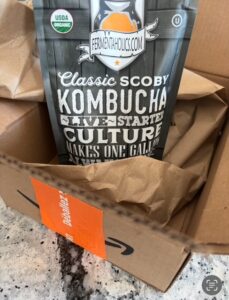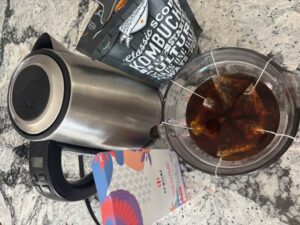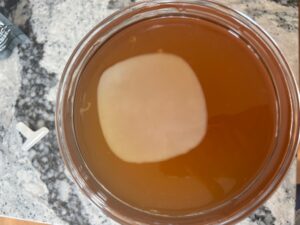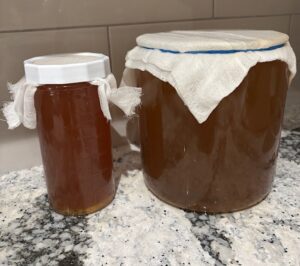Despite connecting with several people on Facebook, I soon discovered that their SCOBYs weren’t quite ready to share. Turns out, growing and brewing Kombucha is a bit of a waiting game. So on to Plan B, problem solve.  Last Sunday, I ordered a starter kit from a Canadian company, Hoochy Booch in Vancouver, thank you, Instagram algorithm. But by Saturday, even though I swore I’d paid for express shipping, there was nothing in sight. Pivot. Amazon, stage right, with a SCOBY that promised to arrive Sunday.
Last Sunday, I ordered a starter kit from a Canadian company, Hoochy Booch in Vancouver, thank you, Instagram algorithm. But by Saturday, even though I swore I’d paid for express shipping, there was nothing in sight. Pivot. Amazon, stage right, with a SCOBY that promised to arrive Sunday.
In preparation, I subscribed to Revolution Fermentation’s newsletter with new recipes and guides and watched the initial video from an online course on making Kombucha.
Similar to Sonia, my daughter was just as eager to dive in. She had listened to the video from the online course with me and joined me in shopping earlier in the week for black tea, cane sugar, cheese cloth, and a jar that would hold our Kombucha. 
We scanned the QR code on the back of the package, which unfortunately, did not take us to the expected directions. My mom soon joined the conversation, with her weekly call, adding in her perspective as I read the directions while boiling water, steeping tea, and measuring sugar.
After removing the tea bags, stirring in the sugar to dissolve, transferring the concentrated tea mixture to a large jar, and measuring in 14 cups of room temperature, filtered water it was time to add in the SCOBY.
 I wonder if 14 cups was a little much to add to my jar as there was not much room to add in the SCOBY. I also wonder if the top of the jar is too large for this size of SCOBY. I covered the top with several layers of cheese cloth and secured it with an elastic band. After reviewing the online course video again my daughter and I thought we might change out the cheese cloth to a thicker cloth to prevent any fruit flies from finding our Kombucha.
I wonder if 14 cups was a little much to add to my jar as there was not much room to add in the SCOBY. I also wonder if the top of the jar is too large for this size of SCOBY. I covered the top with several layers of cheese cloth and secured it with an elastic band. After reviewing the online course video again my daughter and I thought we might change out the cheese cloth to a thicker cloth to prevent any fruit flies from finding our Kombucha.
After making the initial batch of Kombucha I recalled seeing a short on YouTube showing how you could make your own SCOBY from purchased Organic Kombucha so I thought I would experiment with that too as I had a bottle of Synergy in the fridge. As I did not add as much water into the mason jar it took much longer to come to room temperature.
In the meantime, while I waited for the tea mixture to come to room temperature I thought I would explore Dishant’s comment on my last post looking into the Chemistry behind Kombucha. I found a video explaining the Chemistry behind Kombucha, and while I think I will have to watch it more than once to fully understand the chemical reaction, I did have some take aways.
It was interesting to learn from this video that the bacteria in Kombucha produces acetic acid as compared to other forms of fermentation where the bacteria produces lactic acid. Acetic acid bacteria needs oxygen whereas other forms of fermentation do not need oxygen. A take away from this is that Kombucha cannot just be covered over with a lid but needs a cloth that allows it to breathe. A second take away was that as it sits more acetic acid is being produced and the more acidic it becomes. I think it will be interesting to purchase some pH strips to test the different pH levels and perhaps start to understand how this contributes to flavor. 
For now, my two experiments are sitting on my counter. I am looking forward to next week as a friend messaged me while I was writing this post that she has a Kombucha SCOBY ready for me and invited me by to see how she makes Kombucha.
Hey Rhonda,
What a fantastic post! I love how you captured the whole process, the problem-solving with shipping delays, the teamwork with your daughter, and even your mom joining in. It’s clear you’re not just making Kombucha, you’re building an experience around it. Your reflections on the chemistry were really insightful too, especially the point about oxygen and acetic acid. The idea to test pH levels sounds like such a fun way to connect science with flavor. Excited to see how your two experiments (and your friend’s SCOBY) turn out next week!
Thanks so much! I’m really enjoying how this learning project has so many layers including shared learning and making connections. Together we are problem solving. Thinking about the chemistry behind it all makes me curious about why things turn out the way they do.
I like reading about your process, it’s clear you’ve put a lot of thought and care into setting up your first batches, and I think it’s great that your daughter is joining you in the learning too.
One little word of caution from my own experience after several attempts at brewing: you’re absolutely right that the jar shouldn’t be airtight, but that open access made it nearly impossible for me to keep fruit flies out. Even with multiple layers of cheesecloth, I had batches end up contaminated, and I’ll never forget discovering little fruit fly larvae, which is definitely not the kind of “bonus culture” we wanted.
That’s not to scare you off at all, but just something to keep in mind as you experiment with cloth thickness and jar size. If you can get a tighter weave cloth or a specially designed cover, it might help prevent those uninvited guests while still letting your brew breathe.
I’m excited to see how your SCOBYs develop, especially since you’re trying two different approaches. Looking forward to hearing how your first tastings turn out!
Thank you for this tip! As careful as I try to be in keeping out fruit flies flies, I always seem to bring in some fruit flies when bringing in produce/a plant in the fall. I changed out the cheesecloth to a bamboo cotton t-shirt material I had. I hope that is a tight enough weave. I will look into the cover you mention. I went down a rabbit hole on Reddit looking up what would fruit fly larva look like and was a little horrified at these maggot like creatures. Now I am going to be a little paranoid in watching to see if any fruit fly larvae appear. I hope my first attempts have not been contaminated.
Hey Rhonda,
Wow, this was such an interesting read! I like how you shared the whole process step by step — from searching for a SCOBY to finally starting your own Kombucha. It’s great that your daughter and even your mom joined in; it makes it feel like a family project. I didn’t know that Kombucha needs air to breathe and that it produces acetic acid instead of lactic acid — that was a cool fact. I think it’s smart that you’re trying different experiments, like making your own SCOBY and testing pH levels. Can’t wait to hear how your batches turn out next week!
Thank you! I’ve been thinking about how shared learning or with people we are close to adds a layer of connection and memory (and is definitely more fun!). It reminded me of learning with my grandma in the garden or baking and cooking when I was younger. Those experiences stuck with me not just because of the skills I gained, but because of the relationships and stories tied to them. Generational learning is meaningful and lasting. It really is special to share experiences with my daughter and mom. It turns the project into more than just making something; it becomes part of a shared story.
Hey Rhonda
I love how adventurous and curious you are with making Kombucha! From pivoting between Amazon and local kits to experimenting with different SCOBYs and cloths, your problem-solving skills are impressive and entertaining. I can practically picture the tea steeping, sugar dissolving, and that SCOBY floating like a tiny alien in your jar. Your exploration of the chemistry behind fermentation adds a neat scientific twist, too. I have to admit, reading this made me both intrigued and a little hungry for a sip, I would love to taste your Kombucha, though I promise not to start a fruit fly rebellion in the process!